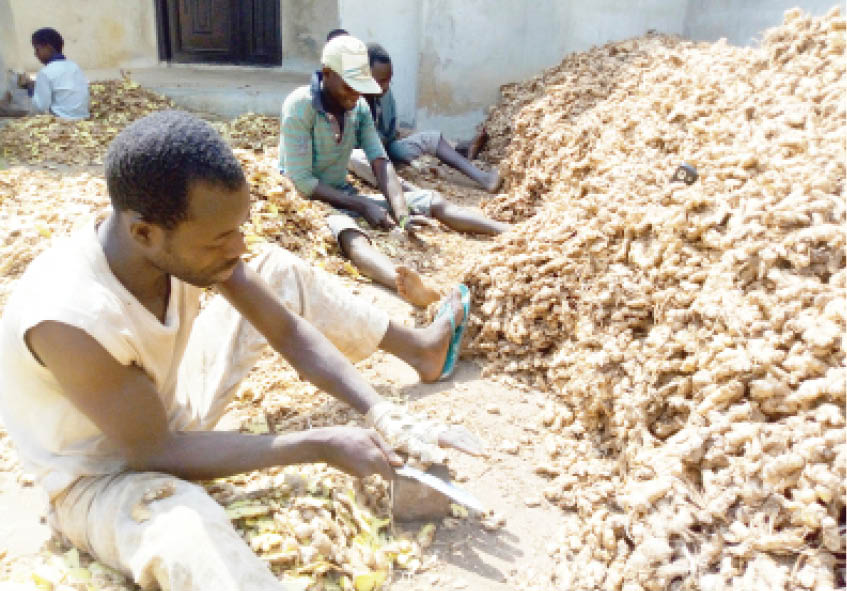When it comes to ginger, Nigeria ranks first in terms of the percentage of total hectares under cultivation, but her contribution to total global output is low when compared to other countries.
The main areas under ginger cultivation globally are Nigeria (56.23%), India (23.6%), China (4.47%), Indonesia (3.37%) and Bangladesh (2.32%).
The low output is attributable to the fact that most of the production is undertaken by smallholder farmers’ old traditional production techniques, and they are constrained by many problems.
One of these is that farmers do not take ginger farming as a serious business.
Also, the areas of land cultivated by majority of the farmers were small, until recently.
In 2016, ginger farmers cultivated an average of 0.25 hectares. Nowadays, the average farm size is between 0.5 and 1.0 hectre.
Ginger, which is a root crop and a typical herb extensively grown across the world for its pungent aromatic under-ground stem or rhizome, is an important export commodity globally, with demand growing in Asia, Europe and America.
Ginger cultivation started in the country in 1927 around Kwoi, Kubacha, Kafanchan and Kagarko areas of southern Kaduna State and around the neighbouring parts of Plateau State.
Worldwide, over 25 varieties of ginger are grown.
However, only two major varieties are grown in Nigeria.
They are reddish and yellow varieties.
The various cultivars available in Nigeria are UG1, UG2 and Maran.
The UG1 yields higher than UG2, which is reported to be more pungent.
The plant is now cultivated in different parts of Nigeria.

Ginger are now produced in Nasarawa, Sokoto, Benue, Osun, Anambra, Zamfara, Akwa Ibom, Oyo, Abia and Lagos states.
But southern Kaduna remains the largest producer of fresh ginger in Nigeria.
The varieties produced in Nigeria are locally referred to as ‘Taffin Giwa’ and ‘Yatsun Biri.’
The ‘Yatsun Biri’ has higher monoterpene and oil, which give it more pungent aroma and pungency.
Therefore, it is usually preferred for the production of oils and oleoresin.
The refreshing aroma and pungent taste of ginger makes it an essential ingredient in diverse cuisines and the food processing industries around the world.
Ginger is available in three forms, namely, fresh root, preserved and dried.
The solvent extract, known as oleoresin, is available in consumer-friendly packages.
Ginger powder is also an ingredient in many blend spice mixes.
Studies have identified more than 400 different compounds in ginger.
Prof Hussaini Doko Ibrahim, the director-general, Raw Materials Research and Development Council (RMRDC), explained that in 2016, Nigeria was the third highest exporter of ginger, preceded by China and India.
However, Nigeria’s production of ginger has been on the increase.
In 2017, Nigeria produced 349,900 tonnes of ginger, which represented 11.5 per cent of global output.
Production in 2018 and 2019 was 368,019 and 375,305 tonnes, respectively.
Out of the quantities produced, 10 per cent was consumed fresh locally, while 90 per cent was consumed in the dried form.
About 20 per cent of the dried ginger was consumed locally for various uses, while the remaining 80 per cent was exported.
The Nigerian ginger is rated as one of the best in the international market due to its pungency and high level of oleoresin oil, a highly sought after ingredient.
Professor Ibrahim mentioned the main limitations of the Nigerian ginger to include the lack of development of production, markets and processing facilities, as well as the disparity between the amount of profit between farmers and traders, irregular weather conditions and the limited number of varieties.
In addition, one of the biggest challenges Nigeria faces is low value addition.
To solve these challenges, the agency initiated a ginger development strategy, which has impact on production, processing and marketing in Nigeria.
Under the Boosting of Agricultural Raw Materials for Industrial Use programme, the Council, in the early 1990s, collaborated with the National Root Crops Research Institute (NRCRI), Umudike, to produce and distribute high quality ginger planting materials to farmers’ associations in the country.
The director-general said that the council recently provided two tons of organic ginger rhizomes to South-West ginger producers, processors and marketers to boost the production and yield of organic ginger in Nigeria as it is safer, healthier and tastier than regular ginger, and because of its increasing popularity in the global market.
A major component of the capacity building initiatives was the training of more than 500 farmers on methods of producing, harvesting and packaging of ginger in ways that will ensure that the commodity is not affected by aflatoxin.
They were also trained on the application of aflasafe.
Also, the Council collaborated with the Ladoke Akintola University of Technology (LAUTECH), Ogbomosho, to promote the propagation and utilisation of organic ginger in line with best international standards.
The RMRDC is also collaborating with other relevant bodies to propagate more organic ginger rhizomes in Nigeria.
In collaboration with the NRCRI, Umudike and Farm Industries, Owerri, respectively, the council has promoted the design and fabrication of ginger splitting machine and drying equipment for commercial processing of the crop.
Each complete set of the plant comprises of a splitting machine, dryer, washing machine and digital moisture meter.
Some of the equipment is being utilised at Mbaitoli Local Government Area of Imo State by the Ginger Growers Association. The council is also collaborating with Belphins Nigeria Ltd. to set up an investment project on split-dried ginger production in Nigeria.
The business plan/feasibility report for the project has been prepared. Likewise, RMRDC’s collaboration with Tiger Foods Ltd, Onitsha, has led to the local sourcing of ginger for processing into value added products by the company.
Professor Ibrahim also noted that “the bulk of ginger produced in Nigeria is exported in split-dried form. Importing countries usually process this into industrial products, mainly ginger powder, essential oils, oleoresin etc.
“The products are imported into the country at higher cost, underscoring the need for value addition to the commodity within the country.
“As a result of this, the council has been in the vanguard of promoting ginger value chain development in the country.
“On the basis of this, the council identified Belphins Nigeria Ltd, Kafanchan, Kaduna State as the only company with the capacity to produce ginger oleoresin in Nigeria, while Tiger Foods Ltd was identified as a major player in the processing of other ginger value-added products.”
Ginger oleoresin is an important secondary raw material in the pharmaceutical, food and beverage industries.
The council collaborated with the two companies to promote ginger exportable products.
In the course of the collaboration, laboratory analyses were carried out on samples of oleoresin produced by Belphins Nigeria Ltd at the Institute of Public Analysts of Nigeria (IPAN) and the National Agency for Food and Drug Administration and Control (NAFDAC).
The outcome of the analyses formed the basis for the advocacy with the organised private sector.
The council organised a roundtable/advocacy meeting on the utilisation of locally produced ginger oleoresin by Nigeria’s industries.
The programme held at Manufacturers’ Association of Nigeria (MAN) House, Ikeja, Lagos on July 3, 2019 and was attended by industrialists in the food and beverage, pharmaceutical sectors, as well as other user industries.
One of the key recommendations of the advocacy meeting was for the council to liaise with the Standard Organisation of Nigeria (SON) to develop the Nigerian Industrial Standard (NIS) on oleoresin. Consequently, the liaison with SON has been initiated.
Further to this initiative, the council, in collaboration with a private engineering firm, is about to complete the design and fabrication of oleoresin extractors,” he stated.
According to him, a number of private sector investors have indicated interest in oleoresin production from ginger, and are working in conjunction with the Council for the actualisation of the project.
The council’s initiative on ginger development is gradually increasing production in the country.
This is also impacting positively on foreign exchange earnings, as presently, up to 23 per cent of Nigeria’s Gross Domestic Product comes from ginger exports.
Growth in exports increased significantly over the years when total export value increased almost four times.
Also, increase in ginger production and processing is gradually leading to reduction in spice importation in the country.
And the council is increasing the tempo of its activities in the area of ginger value chain development.
The objective, as outlined in the RMRDC strategic plan, is to increase local capacity in the design and fabrication of more ginger processing facilities.
The council is also working closely with stakeholders’ on the Technical Tariff Committee (TTC) to handle as appropriate, the tariff for ginger oleoresin and other products imported into this country.
This is to encourage increased local production and processing of ginger in Nigeria.

 Join Daily Trust WhatsApp Community For Quick Access To News and Happenings Around You.
Join Daily Trust WhatsApp Community For Quick Access To News and Happenings Around You.


